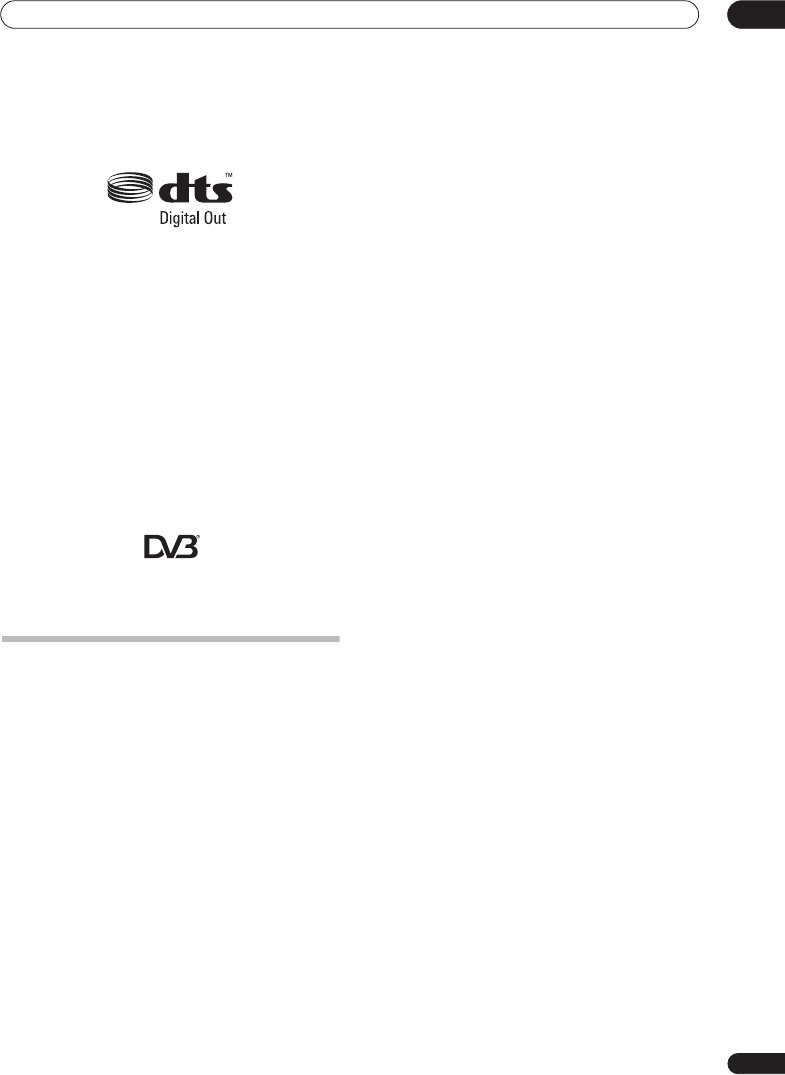
Before you start
01
47
En
DTS
“DTS” and “DTS Digital Out” are registered trademarks of
DTS, Inc.
DVB
The Digital Video Broadcasting Project, or DVB for short,
is a set of open standards for digital broadcasting,
covering terrestrial, cable and satellite broadcasts.
Based around the MPEG-2 coding system, these open
standards ensure that compliant systems are able to
work together, independent of manufacturer.
DVB is extremely flexible, being able to deliver virtually
any kind of digital content to the home, including High
Definition and Standard Definition TV, broadband
multimedia content and interactive services.
DVB is a registered trademark of the DVB Project.
About the internal hard disk drive
The internal hard disk drive (HDD) is a fragile piece of
equipment. When used without the proper care or in the
wrong conditions, it is possible that recorded contents
may be damaged or lost entirely, in some cases making
even normal playback or recording impossible. Please
understand that in the event of repair or replacement of
the HDD or related components, all your HDD recordings
will be lost.
Please use the recorder following the guidelines below to
protect against possible HDD failure.
The HDD should not be regarded as a place to store
recordings permanently. We recommend that you back up
your important recordings onto DVD discs in order to
protect against accidental loss.
Pioneer cannot under any circumstances accept
responsibility for any direct or indirect loss arising from any
inconvenience or loss of recorded material resulting from
HDD failure.
• Do not move the recorder while it is on (this includes
during EPG download when the display shows
EPG
).
• Install and use the recorder on a stable, level surface.
• Do not block the rear vent/cooling fan.
• Do not use the recorder in excessively hot or humid
places, or in places that may be subject to sudden
changes in temperature. Sudden changes in
temperature can cause condensation to form inside
the recorder. This can be a cause of HDD failure.
• While the recorder is switched on (including during
EPG download when the display shows
EPG
), do not
unplug from the wall socket or switch the electricity
off from the breaker switch.
• Do not move the recorder immediately after
switching it off. If you need to move the recorder,
please follow the steps below:
1
After the message
POWER OFF
is shown on the
front panel display, wait at least two minutes.
2
Unplug from the wall socket.
3
Move the recorder.
• If there’s a power failure while the recorder is on
there is a chance that some data on the HDD will be
lost.
• The HDD is very delicate. If used over time in an
improper manner or in an unsuitable environment, it
is possible that the HDD will fail. Signs of problems
include playback unexpectedly freezing and
noticeable block noise (mosaic) in the picture.
However, sometimes there will be no warning signs
of HDD failure. If the HDD fails, no playback of
recorded material will be possible. In this case it will
be necessary to replace the HDD unit.
Optimizing HDD performance
As you record and edit material on the HDD, the data on
the disk becomes fragmented, eventually affecting the
recorder’s performance. Before this happens, the
recorder will warn you that it is time to optimize the HDD
(which you can do from the Disc Setup menu; see
Optimize HDD
on page 133).
DVRLX60D_WV_EN.book 47 ページ 2007年4月24日 火曜日 午後7時58分


















